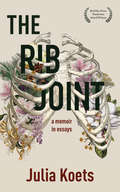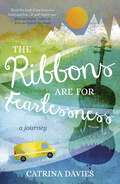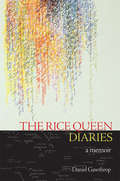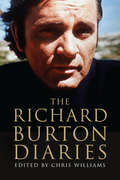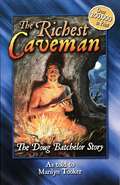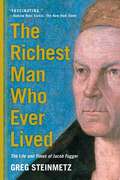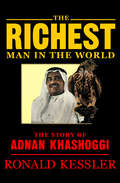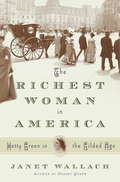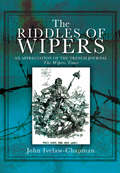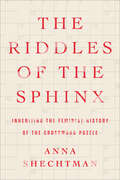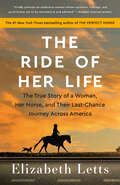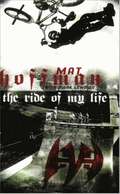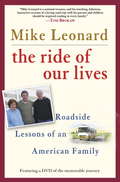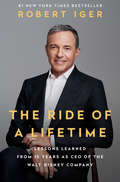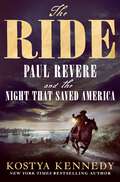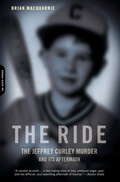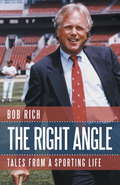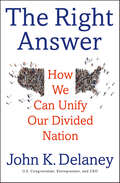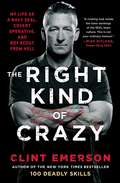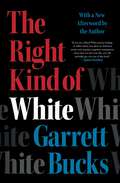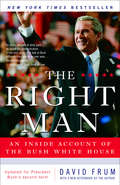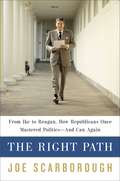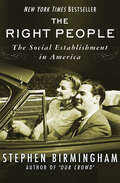- Table View
- List View
The Rib Joint: A Memoir in Essays
by Julia Koets&“This dazzling writer has created a guidebook for growing up queer in the American South . . . a testament to human endurance and dignity.&” —Nick White, author of Sweet & Low Growing up in a small town in the South, Julia and her childhood best friend Laura know the church as well as they know each other&’s bodies—the California-shaped scar on Julia&’s right knee, the tapered thinness of Laura&’s fingers, the circumference of each other&’s ponytails. When Laura&’s family moves away in middle school and Julia gets a crush on the new priest&’s daughter at their church, Julia starts to more fully realize the consequences of being anything but straight in the South. After college, when Julia and her best friend Kate wait tables at a rib joint in Julia&’s hometown, they are forced to face the price of the secrets they&’ve kept—from their families, each other, and themselves. From astronaut Sally Ride&’s obituary, to a UFO Welcome Center, to a shark tooth collection, to DC Comic&’s Gay Ghost, this memoir-in-essays draws from mythology, religion, popular culture, and personal experience to examine how coming out is not a one-time act. At once heartrending and beautiful, The Rib Joint explores how fear and loss can inhabit our bodies and, contrastingly, how naming our desire allows us to feel the heart beating in our chest. &“A brilliant, unsettling book.&” —Paul Lisicky, author of Later &“Engaging, poignant, and at times wryly humorous . . . Julia Koets writes with vulnerability, warmth, and a lyrical style that pulls the reader straight through to the end.&” —Kristen Iversen, author of Full Body Burden
The Ribbons are for Fearlessness: A Journey
by Catrina DaviesDevastated by her lover leaving and trapped in a dead-end job, Catrina’s friend Andrew comes up with a plan: they'll busk their way from Norway to Portugal in a van. When Andrew is killed in a tragic accident Catrina decides to go it alone and discovers the real meaning of love and courage, and the importance of following her dreams.
The Rice Queen Diaries
by Daniel GawthropIn this moving autobiography, Daniel Gawthrop writes about the politics and pleasures of being a self-identified "rice queen": a gay man who is attracted to Asians. Navigating through the urban jungles of Western cities like Vancouver and London, as well as the humid streets of Bangkok and Hanoi, Daniel explores the multicultural minefields of sexuality and culture as he articulates the manners and contradictions of his desires. <P> The politics of race, and the unspoken rules of gay Asian culture in both Western and Eastern settings, underscore Daniel's personal journey, in which he recalls his teen years spent idolizing Bruce Lee and his fixation on an Asian schoolmate whose hazing becomes a sexual spectacle for him. As he enters adulthood, his desires become manifest as he explores the subcultures of Long Yang Clubs (where gay Asians and "their admirers" can meet) before departing for Asia, where his encounters become transactions, and he learns the hard way that sexual desire has a human and emotional cost. <P> Evoking the themes of Edward Said's Orientalism, The Rice Queen Diaries is as much a personal statement about culture and otherness as it is about gay desire. Traversing three continents, these diaries are a personal reckoning, a bold coming to terms with the nuances of sexuality that has relevance for all of us.
The Richard Burton Diaries
by Chris WilliamsIrresistibly magnetic on stage, mesmerizing in movies, seven times an Academy Award nominee, Richard Burton rose from humble beginnings in Wales to become Hollywood's most highly paid actor and one of England's most admired Shakespearean performers. His epic romance with Elizabeth Taylor, his legendary drinking and story-telling, his dazzling purchases (enormous diamonds, a jet, homes on several continents), and his enormous talent kept him constantly in the public eye. Yet the man behind the celebrity façade carried a surprising burden of insecurity and struggled with the peculiar challenges of a life lived largely in the spotlight. This volume publishes Burton's extensive personal diaries in their entirety for the first time. His writings encompass many years—from 1939, when he was still a teenager, to 1983, the year before his death—and they reveal him in his most private moments, pondering his triumphs and demons, his loves and his heartbreaks. The diary entries appear in their original sequence, with annotations to clarify people, places, books, and events Burton mentions. From these hand-written pages emerges a multi-dimensional man, no mere flashy celebrity. While Burton touched shoulders with shining lights—among them Olivia de Havilland, John Gielgud, Claire Bloom, Laurence Olivier, John Huston, Dylan Thomas, and Edward Albee—he also played the real-life roles of supportive family man, father, husband, and highly intelligent observer. His diaries offer a rare and fresh perspective on his own life and career, and on the glamorous decades of the mid-twentieth century.
The Richest Caveman: The Doug Batchelor Story
by Marilyn Tookerthe teenage son of a millionaire father and a show-business mother, Doug Batchelor had everything money could buy--everything but happiness. He used drugs, fought at school, and entertained suicidal fantasies. Disgusted with himself and convinced that life held no purpose, Doug was determined to grab all the fun and excitement he could find. Before his search ended, a cave in the hills above Palm Springs became his home. And although his father owned a yacht, a Lear jet, and an airline, Doug would eventually scavenge for food in garbage bins. The happiness Doug wanted eluded him until the day he began reading the dust-covered Bible a fellow “searcher” had left behind in his cave. What happened next can only be described as a miracle.
The Richest Man Who Ever Lived: The Life and Times of Jacob Fugger
by Greg SteinmetzThe life and times of the wealthiest man who ever lived--Jacob Fugger--the Renaissance banker who revolutionized the art of making money and established the radical idea of pursuing wealth for its own sake.Jacob Fugger lived in Germany at the turn of the sixteenth century, the grandson of a peasant. By the time he died, his fortune amounted to nearly two percent of European GDP. Not even John D. Rockefeller had that kind of wealth. Most people become rich by spotting opportunities, pioneering new technologies, or besting opponents in negotiations. Fugger did all that, but he had an extra quality that allowed him to rise even higher: nerve. In an era when kings had unlimited power, Fugger had the nerve to stare down heads of state and ask them to pay back their loans--with interest. It was this coolness and self-assurance, along with his inexhaustible ambition, that made him not only the richest man ever, but a force of history as well. Before Fugger came along it was illegal under church law to charge interest on loans, but he got the Pope to change that. He also helped trigger the Reformation and likely funded Magellan's circumnavigation of the globe. His creation of a news service, which gave him an information edge over his rivals and customers, earned Fugger a footnote in the history of journalism. And he took Austria's Habsburg family from being second-tier sovereigns to rulers of the first empire where the sun never set. The ultimate untold story, The Richest Man Who Ever Lived is more than a tale about the richest and most influential businessman of all time. It is a story about palace intrigue, knights in battle, family tragedy and triumph, and a violent clash between the 1 percent and everybody else. To understand our financial system and how we got it, it pays to understand Jacob Fugger.
The Richest Man in Town
by V. J. SmithLike millions of people, I thought success equaled happiness. The book I've written, though, is about a simple man who ran a cash register. He worked hard and was good to people. That, in turn, made him happy. Can it be so simple--so free of complications? Marty thought so. He showed me how to be a better person, not one wealthier or more successful or more powerful.
The Richest Man in the World: The Story of Adnan Khashoggi
by Ronald KesslerNew York Times bestselling author and award-winning reporter Ronald Kessler goes inside the infamously lavish life of billionaire Adnan Khashoggi, once the richest man in the world.He made more money - and more quickly - than anyone in history. And he spent it at a dizzying clip of $330,000 a day, every day of the year. He was Adnan Mohamed Khashoggi, a Saudi Arabian middleman who started out with nothing and in twenty-five years parlayed his connections to the Saudi royal family and genius at dealing with people into a fortune of colossal proportions. Khashoggi's American Express bill often exceeded $1 million. When he felt like having spaghetti, he flew to Venice for dinner on one of his three commercial-size airplanes. One of his luxury yachts, the 282-foot Nabila, was considered the most opulent modern yacht afloat and was borrowed for a James Bond movie. This remarkable book is a rare glimpse into a life of opulence beyond most people's wildest imaginings - a compelling closeup of a complex and driven man who has explored the outer reaches of success, power, and all that money can buy.
The Richest Woman in America: Hetty Green in the Gilded Age
by Janet WallachA captivating biography of America's first female tycoon, Hetty Green, the iconoclast who forged one of the greatest fortunes of her time. No woman in the Gilded Age made as much money as Hetty Green. At the time of her death in 1916, she was worth at least 100 million dollars, equal to more than 2 billion dollars today. A strong believer in women being financially independent, she offered valuable lessons for the present times. Abandoned at birth by her neurotic mother, scorned by her misogynist father, Hetty set out as a child to prove her value. Following the simple rules of her wealthy Quaker father, she successfully invested her money and along the way proved to herself that she was wealthy and therefore worthy. Never losing faith in America's potential, she ignored the herd mentality and took advantage of financial panics and crises. When everyone else was selling, she bought railroads, real estate, and government bonds. And when everyone was buying and borrowing, she put her money into cash and earned safe returns on her dollars. Men mocked her and women scoffed at her frugal ways, but she turned her back and piled up her earnings, amassing a fortune that supported businesses, churches, municipalities, and even the city of New York itself. She relished a challenge. When her aunt died and did not leave Hetty the fortune she expected, she plunged into a groundbreaking lawsuit that still resonates in law schools and courts. When her husband defied her and sank her money on his own risky interests, she threw him out and, marching down to Wall Street, quickly made up the loss. Her independence, outspokenness, and disdain for the upper crust earned her a reputation for harshness that endured for decades. Newspapers kept her in the headlines, linking her name with witches and miscreants. Yet those who knew her admired her warmth, her wisdom, and her wit. Set during a period of financial crisis strikingly similar to our current one, acclaimed author Janet Wallach's engrossing exploration of a fascinating life revives a rarely-mentioned queen of American finance.
The Riddles Of Wipers: An Appreciation of the Trench Journal "The Wipers Times"
by John Ivelaw-ChapmanThe Wipers Times was the Private Eye of the Ypres Salient during World War One. Edited, while under bombardment, by a battalion commander in the Sherwood Foresters, written by soldiers actually in the trenches and distributed by ration-wagon and ammunition-mule. the paper bears vivid witness to the shocking realities of trench warfare. Yet for all the occasional horror of its content, The Wipers Times was a gentle, humor-filled and satirical paper which, once its codes are cracked and its riddles solved, tells an interested reader much about the characters and personalities of the men in the British Army of the First World War.Interpretation of regular features such as the bogus music-hall advertisements that feature in every issue, columns like Answers to our Many Correspondents and Things We Want to Know and careful study of some of the remarkable poetry published in the paper, explain to readers what it was like to be there. The Mud, the Gas, the Shells; the Fear, the Courage, the Humour and the Bitterness; much is revealed about these and many other things in this remarkable book that unravels the eighty-year-old Riddles of Wipers.
The Riddles of the Sphinx: Inheriting the Feminist History of the Crossword Puzzle
by Anna Shechtman"A surprising and ambitious investigation of language and the varied ways women resist the paradoxes of patriarchy both on and off the page."—New York TimesCombining the soul-baring confessional of Brain on Fire and the addictive storytelling of The Queen’s Gambit, a renowned puzzle creator’s compulsively readable memoir and history of the crossword puzzle as an unexpected site of women’s work and feminist protest.The indisputable “queen of crosswords,” Anna Shechtman published her first New York Times puzzle at age nineteen, and later, helped to spearhead the The New Yorker’s popular crossword section. Working with a medium often criticized as exclusionary, elitist, and out-of-touch, Anna is one of very few women in the field of puzzle making, where she strives to make the everyday diversion more diverse.In this fascinating work—part memoir, part cultural analysis—she excavates the hidden history of the crossword and the overlooked women who have been central to its creation and evolution, from the “Crossword Craze” of the 1920s to the role of digital technology today. As she tells the story of her own experience in the CrossWorld, she analyzes the roles assigned to women in American culture, the boxes they’ve been allowed to fill, and the ways that they’ve used puzzles to negotiate the constraints and play of desire under patriarchy.The result is an unforgettable and engrossing work of art, a loving and revealing homage to one of our most treasured, entertaining, and ultimately political pastimes.
The Ride of Her Life: The True Story of a Woman, Her Horse, and Their Last-Chance Journey Across America
by Elizabeth LettsThe triumphant true story of a woman who rode her horse across America in the 1950s, fulfilling her dying wish to see the Pacific Ocean, from the #1 New York Times bestselling author of The Perfect Horse and The Eighty-Dollar Champion&“The gift Elizabeth Letts has is that she makes you feel you are the one taking this trip. This is a book we can enjoy always but especially need now.&”—Elizabeth Berg, author of The Story of Arthur Truluv In 1954, sixty-three-year-old Maine farmer Annie Wilkins embarked on an impossible journey. She had no money and no family, she had just lost her farm, and her doctor had given her only two years to live. But Annie wanted to see the Pacific Ocean before she died. She ignored her doctor&’s advice to move into the county charity home. Instead, she bought a cast-off brown gelding named Tarzan, donned men&’s dungarees, and headed south in mid-November, hoping to beat the snow. Annie had little idea what to expect beyond her rural crossroads; she didn&’t even have a map. But she did have her ex-racehorse, her faithful mutt, and her own unfailing belief that Americans would treat a stranger with kindness.Annie, Tarzan, and her dog, Depeche Toi, rode straight into a world transformed by the rapid construction of modern highways. Between 1954 and 1956, the three travelers pushed through blizzards, forded rivers, climbed mountains, and clung to the narrow shoulder as cars whipped by them at terrifying speeds. Annie rode more than four thousand miles, through America&’s big cities and small towns. Along the way, she met ordinary people and celebrities—from Andrew Wyeth (who sketched Tarzan) to Art Linkletter and Groucho Marx. She received many offers—a permanent home at a riding stable in New Jersey, a job at a gas station in rural Kentucky, even a marriage proposal from a Wyoming rancher. In a decade when car ownership nearly tripled, when television&’s influence was expanding fast, when homeowners began locking their doors, Annie and her four-footed companions inspired an outpouring of neighborliness in a rapidly changing world.
The Ride of My Life
by Mat Hoffman Mark LewmanI had seriously reached a point in my life where I wasn't scared of anything. Panic was replaced by awww, shit, how can I fix this before I hit the ground?Childhood for Mat Hoffman was packed with hazardous behavior and a constant searching for a new rush: sliding down the laundry chute, blatantly misusing a trampoline, leaping off the roof holding an umbrella, executing a two-story bomb drop into a swimming pool on a bike, and more. After experimenting with his bike on a plywood ramp at age eleven, Mat found his true calling. He became addicted to aerials.By the time he was fourteen years old, Mat had earned national notoriety with his ramp skills and landed a factory sponsorship from Skyway Recreation. He was consumed by a love of bike riding, a passion that took him around the globe and beyond the limits of what people said was possible. Always pushing for more height or another way to turn air into art, he's shattered world records, conventional wisdom, and his own body in a quest to experience all that life has to offer. The price? More than a dozen major surgeries, fifty broken bones, countless concussions and knockouts -- Mat's sacrifices are evident in a medical file that's 400 pages thick.When the boom years of BMX freestyle bottomed out during a bike industry recession in the late 1980s, Mat's enthusiasm never wavered. To save his sport, he bought a semi truck when he was seventeen and became his own sponsor, spreading the word one demo at a time. He and his friends formed Hoffman Bikes and began running bike stunt contests. It was an era of progress for Mat as a rider, as he unveiled jawdropping tricks like the no-handed 540, backflip fakie, and flair, and became the first rider in action sports to pull a 900.In The Ride of My Life, Mat takes readers on his humorous, hardcore, harrowing journey to the top as a bike stunt pioneer, ten-time world champion, video game superstar, X Games ambassador, recreational ninja, and the most innovative rider to ever hit a ramp. He shares stories of the wild experiences he's had while touring with some of the best riders around -- Dennis McCoy, Dave Mirra, Rick Thorne, Kevin Robinson, Mike "Rooftop" Escamilla, and many others.Spanning two decades of action sports history, as Mat crosses paths with high-risk heroes like Tony Hawk, Johnny Knoxville, and Evel Knievel, The Ride of My Life is the insane, true story of Mat Hoffman, the greatest bike rider of all time.
The Ride of Our Lives
by Mike LeonardThe open road awaited us. Only one thing held us back. 'Son of a bitch!' 'Marge,' pleaded my father, 'we can't move until you sit down. What the hell are you looking for?' 'I can't find my goddamn holy card. ' 'What holy card?' I asked. 'My Mother Teresa holy card. ' She answered, crawling on the floor. 'She's a saint. She's gonna get me there and get me home. Now where the hell is she?' The Ride of Our Lives is the humorous yet poignant account of NBC journalist Mike Leonard's cross-country odyssey with his feisty parents, both 'world-class eccentrics cut from the same bolt of Irish immigrant cloth'. Mike wanted his parents to revisit the things they held dear from their past, ending in Chicago in time for the birth of their first great-grandchild. But this is no ordinary road trip - rather, it's a jumping off point for a rich and wonderful foray into memory, family and home-grown wisdom. A four-week adventure turns into the journey of a lifetime as Mike's family revisit their shared past, both physically and emotionally - from stories of Irish immigration and the Great Depression to the precious gift of a great-grandmother's ring; and from anecdotes of long-ago childhood to the anticipation of a new generation. And along the way, Mike's parents, in their own unique style, reminisce about their loves, their losses, and their full and generous lives; sharing and arguing, laughing and crying - the bottom line is that family is what truly matters most. Film rights have been optioned by Disney.
The Ride of a Lifetime: Lessons Learned from 15 Years as CEO of the Walt Disney Company
by Robert IgerA grand vision defined: The CEO of Disney, one of Time’s most influential people of 2019, shares the ideas and values he embraced to reinvent one of the most beloved companies in the world and inspire the people who bring the magic to life. Robert Iger became CEO of The Walt Disney Company in 2005, during a difficult time. Competition was more intense than ever and technology was changing faster than at any time in the company’s history. His vision came down to three clear ideas: Recommit to the concept that quality matters, embrace technology instead of fighting it, and think bigger—think global—and turn Disney into a stronger brand in international markets. Twelve years later, Disney is the largest, most respected media company in the world, counting Pixar, Marvel, Lucasfilm, and 21st Century Fox among its properties. Its value is nearly five times what it was when Iger took over, and he is recognized as one of the most innovative and successful CEOs of our era.In The Ride of a Lifetime, Robert Iger shares the lessons he’s learned while running Disney and leading its 200,000 employees, and he explores the principles that are necessary for true leadership, including:• Optimism. Even in the face of difficulty, an optimistic leader will find the path toward the best possible outcome and focus on that, rather than give in to pessimism and blaming.• Courage. Leaders have to be willing to take risks and place big bets. Fear of failure destroys creativity. • Decisiveness. All decisions, no matter how difficult, can be made on a timely basis. Indecisiveness is both wasteful and destructive to morale. • Fairness. Treat people decently, with empathy, and be accessible to them. This book is about the relentless curiosity that has driven Iger for forty-five years, since the day he started as the lowliest studio grunt at ABC. It’s also about thoughtfulness and respect, and a decency-over-dollars approach that has become the bedrock of every project and partnership Iger pursues, from a deep friendship with Steve Jobs in his final years to an abiding love of the Star Wars mythology. “The ideas in this book strike me as universal” Iger writes. “Not just to the aspiring CEOs of the world, but to anyone wanting to feel less fearful, more confidently themselves, as they navigate their professional and even personal lives.”
The Ride: Paul Revere and the Night That Saved America
by Kostya KennedyTimed for the 250th anniversary of one of America’s most famous founding events: Paul Revere’s heroic ride, newly told with fresh research into little-known aspects of the story Americans have heard since childhood but hardly understoodOn April 18, 1775, a Boston-based silversmith, engraver, and anti-British political operative named Paul Revere set out on a borrowed horse to fulfill a dangerous but crucial mission: to alert American colonists of advancing British troops, which would seek to crush their nascent revolt.Revere was not the only rider that night, and indeed, he had completed at least 18 previous rides across New England and other colonies, disseminating intelligence about British movements. But this ride was like no other, and its consequences in the months and years to come—as the American Revolution morphed from isolated skirmishes to a full-fledged war—became one of our founding legends.In The Ride, Kostya Kennedy presents a dramatic new narrative of the events of April 18 and 19, 1775, informed by fresh primary and secondary source research into archives, family letters and diaries, contemporary accounts, and more. Kennedy reveals Revere’s ride to be more complex than it is usually portrayed—a loosely coordinated series of rides by numerous men, near-disaster, capture by British forces, and finally success. While Revere was central to the ride and its plotting, Kennedy reveals the other men (and, perhaps, a woman with information about the movement of British forces) who helped to set in motion the events that would lead to America’s independence.Thrillingly written in a dramatic, unstoppable narrative, The Ride re-tells an essential American story for a new generation of readers.
The Ride: The Jeffrey Curley Murder and Its Aftermath
by Brian Macquarrie"The Ride" tells the shocking true story of the 1997 abduction and gruesome murder of ten-year-old Massachusetts resident Jeffrey Curley, and how his father, Bob, healed the deep wounds of rage and emerged to become an outspoken critic of the death penalty.
The Right Angle: Tales of a Sporting Life
by Bob Rich"Erma Bombeck meets Ernest Hemingway." That's how a friend described his impressions of Bob Rich's stories. You may find yourself agreeing as you read these entertaining tales about the adventures of an avid sportsman and entrepreneur told with the light touch of a humorist. Bob Rich has always been a gamer, from his first hockey games as a kid on the ice rinks of Buffalo through his adult life on the high seas in pursuit of record sport fish. Games have defined him in business, sports, and life. In this collection of colorful vignettes spanning four decades, Rich recounts some of the major highlights of his sporting life and his career. Western New Yorkers will be especially interested in his discussion of his activities in the local community: pioneering the art of purchasing the naming rights for a professional football stadium--Rich Stadium--where the Buffalo Bills play; buying and selling a National Hockey League franchise--the Buffalo Sabres--twice; and pursuing the dream of Major League Baseball in his hometown, including behind-the-scene glimpses of Robert Redford's The Natural, which was filmed in Buffalo. Beyond Western New York, Bob describes fishing trips around the world in pursuit of trout with the president of the United States and in search of a thousand-pound blue marlin known as a grander, as well as swimming around Key West, and much more. The combination of vivid characters, intriguing storylines, and Bob Rich's easy, flowing conversational style of writing make this an appealing and enjoyable read.
The Right Answer: How We Can Unify Our Divided Nation
by John K. DelaneyThe first declared candidate for president in 2020 delivers a passionate call for bipartisan action, entrepreneurial innovation, and a renewed commitment to the American ideaThe son of a union electrician and grandson of an immigrant, John K. Delaney grew up believing that anything was possible in America. Before he was fifty, he founded, built and then sold two companies worth billions of dollars. Driven by a deep desire to serve, in 2012 he stepped away from his businesses, ran for Congress, and won. Now he has a new mission: unifying our terribly divided nation and guiding it to a brighter future. As a boy, Delaney learned the importance of working hard, telling the truth and embracing compromise. As an entrepreneur, he succeeded because he understood the need to ensure opportunity for all, focus on the future, and think creatively about problem-solving. In these pages, he illustrates the potency of these principles with vivid stories from his childhood, his career in business, his family, and his new life as a politician. He also writes candidly about the often frustrating experience of working on Capitol Hill, where many of his colleagues care more about scoring political points than improving the lives of their fellow Americans. With a clear eye and an open heart, he explains that only by seeing both sides of anargument and releasing our inner entrepreneur can we get back to constructive, enlightened governing.Seventy years ago, John F. Kennedy appealed to our best instincts when he said, “Let us not seek the Republican answer or the Democratic answer but the right answer.” In this inspiring book, John K. Delaney asks all of us to cast aside destructive, partisan thinking and join him in an urgent endeavor: working together to forge a new era of American greatness.
The Right Kind of Crazy: My Life as a Navy SEAL, Covert Operative, and Boy Scout from Hell
by Clint EmersonClint Emerson, retired Navy SEAL and author of the bestselling 100 Deadly Skills, presents an explosive, darkly funny, and often twisted account of being part of an elite team of operatives whose mission was to keep America safe by whatever means necessary.Clint Emerson is the only SEAL ever inducted into the International Spy Museum. Operating from the shadows, with an instinct for running towards trouble, his unique skill set made him the perfect hybrid operator. Emerson spent his career on the bleeding edge of intelligence and operations, often specializing in missions that took advantage of subterfuge, improvisation, the best in recon and surveillance tech to combat the changing global battlefield. MacGyvering everyday objects into working spyware was routine, and fellow SEALs referred to his activities simply as &“special shit.&” His parameters were: find, fix, and finish—and of course, leave no trace. The Right Kind of Crazy is unlike any military memoir you&’ve ever read because Emerson is upfront about the fact that what makes you a great soldier and sometimes hero doesn&’t always make you the best guy—but it does make for damn good stories.
The Right Kind of White: A Memoir
by Garrett BucksA &“deeply revealing and vulnerable memoir&” (Kate Schatz, New York Times bestselling coauthor of Do the Work) that earnestly reckons with whiteness and explores how understanding one&’s own white identity can create the racial accountability needed in the national discourse.As the product of progressive parents and a liberal upbringing, Garrett Bucks prided himself on the pursuit of being a &“good white person.&” The kind of white person who treats their privilege as a responsibility and not a burden; the kind of white person who people of color see as the peak example of racial allyship; the kind of white person who other white people might model their own aspirations of being &“better&” after. But it&’s Buck&’s obsession with &“goodness&” that prevents him from building meaningful relationships, particularly those who look like him. The Right Kind of White charts Buck&’s intellectual and emotional odyssey in his pursuit of this ideal whiteness, the price of its admission, and the work he&’s doing to bridge the divide from those he once sought distance from.
The Right Man: The Surprise Presidency of George W. Bush
by David FrumThe Right Man is the first inside account of a historic year in the Bush White House, by the presidential speechwriter credited with the phrase axis of evil. David Frum helped make international headlines when President George W. Bush’s 2002 State of the Union address linked international terrorists to Iran, Iraq, and North Korea. But that was only one moment during a crucial time in American history, when a president, an administration, and a country were transformed.Frum worked with President Bush in the Oval Office, traveled with him aboard Air Force One, and studied him closely at meetings and events. He describes how Bush thinks—what this conservative president believes about religion, race, the environment, Jews, Muslims, and America’s future. Frum takes us behind the scenes of one of the most secretive administrations in recent history, with revealing portraits of Karl Rove, Karen Hughes, Condoleezza Rice, and many others. Most significant, he tells the story of the transformation of George W. Bush: how a president whose administration began in uncertainty became one of the most decisive, successful, and popular leaders of our time.Before becoming a White House speechwriter, David Frum was a highly regarded author of books and political commentary and an influential voice on the pages of The Wall Street Journal and The Weekly Standard. His commentary has been described by William F. Buckley as “the most refreshing ideological experience in a generation.” Now, in The Right Man, we see Frum as a front-row observer and participant. Not since Peggy Noonan’s account of her time in the Reagan White House has an insider portrayed a sitting president with such precision, verve, honest admiration, and insight. The Right Man will command international attention for its thoughtful account of George W. Bush in the midst of his greatest challenge. It will be an essential reference for anyone seeking to understand who our president really is and how he is likely to lead us in the future.
The Right Path: From Ike to Reagan, How Republicans Once Mastered Politics--and Can Again
by Joe ScarboroughJoe Scarborough--former Republican congressman and the always insightful host of MSNBC's Morning Joe--takes a nuanced and surprising look at the unexpected rise and self-inflicted fall of the Republican Party. Dominant in national politics for forty years under the influence of the conservative but pragmatic leadership of Dwight Eisenhower and Ronald Reagan, the GOP, Scarborough argues, is in a self-inflicted eclipse. The only way forward? Recover the principled realism of the giants who led the party to greatness. In the aftermath of Lyndon Johnson's 1964 landslide, the Republican Party appeared to be on the verge of permanent irrelevance. LBJ's Great Society was institutionalizing sweeping liberal reforms, and the United States had a thriving, prosperous economy. Yet in an instant everything changed, and the next four decades would witness an unprecedented era of Republican ascendancy. What happened? In The Right Path, Joe Scarborough looks back in time to discern how Republicans once dominated American public life. From Eisenhower's refusal to let "the perfect be the enemy of the good" to Reagan's charismatic but resolutely practical genius, Scarborough shows how principled pragmatism, combined with a commitment to core conservative values, led to victory after victory. Now, however, political incalcitrance is threatening to turn a once-mighty party into a permanent minority. Opening with the passage of the Voting Rights Act in 1965--the high-water moment for liberalism--and ending with the national disillusionment that set in after Hurricane Katrina ravaged New Orleans, The Right Path effortlessly blends American political history with astute analysis and pithy, no-holds-barred commentary. Both a bracing call to arms and a commonsense history, The Right Path provides an illuminating look at conservatism and its discontents--and why the GOP must regain its former tone and tradition if it hopes to survive. Advance praise for The Right Path "The Right Path is the right book at the right time to spark a much-needed conversation about the future of the Republican Party."--Doris Kearns Goodwin "If you're interested in the Republican future, you need to read The Right Path. I don't agree with all of it, but Joe Scarborough has written a book that's both thought-provoking and fun."--William Kristol"Joe Scarborough's lively, provocative, and instructive history of the modern Republican Party will stir up the GOP--which is exactly what he has in mind. As the Grand Old Party searches for a path to victory, Joe offers some important lessons to be learned."--Tom Brokaw "Joe Scarborough's incisive, original, provocative, and well-argued book, deploying American political history both distant and recent, deserves to be widely read, carefully considered, and energetically debated."--Michael Beschloss "Blending political and cultural history with sharp analysis, Joe Scarborough's The Right Path is highly readable, timely, and, most important, provocative. This book comes at a crucial time for the Republican Party."--Craig Shirley"Joe Scarborough, a good Republican, wants to save the Republicans from themselves. In this provocative, lively, and wise book, he shows the way."--Evan Thomas
The Right People: The Social Establishment in America
by Stephen BirminghamAn enlightening and entertaining inside look at the lifestyles of America&’s extremely wealthy from the bestselling author of &“Our Crowd&” It&’s no secret that the rich are different from the rest of us. But the rich, as author Stephen Birmingham so insightfully points out, are also different from the very rich. There&’s Society, and then there&’s Real Society, and it takes multiple generations for families of the former to become entrenched in the latter. Real Society is not about the money—or rather, it&’s not only about the money—it is about history, breeding, tradition, and most of all, the name. The Right People is an engrossing and illuminating journey through the customs and habits of the phenomenally wealthy, from the San Francisco elite to the upper crust of New York&’s Westchester County. It is a marvelously anecdotal, intimately detailed overview of the lives of the American aristocracy: where they gather and dine; their games and sports, clubs and parties, friendships and feuds; their mating, marriage, and divorce rituals—a potpourri of priceless true stories featuring the Astors, Goulds, Vanderbilts, Vanderlips, Dukes, Biddles, and other lofty names from the pages of the Social Register.
